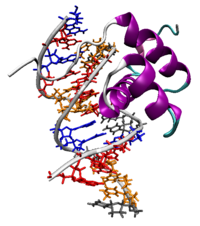
Photo from wikipedia
Significance Vertebrate Hox genes are clustered. This organization has a functional relevance, as the transcription of each gene in time and space depends upon its relative position within the gene… Click to show full abstract
Significance Vertebrate Hox genes are clustered. This organization has a functional relevance, as the transcription of each gene in time and space depends upon its relative position within the gene cluster. Hox clusters display a high organization, and all genes are transcribed from the same DNA strand. Here, we investigate the importance of this uniform transcriptional polarity by engineering alleles where one or several transcription units are inverted, with or without a CTCF site. We observe that inversions are likely detrimental to the proper implementation of this genetic system. We propose that the enhanced organization of Hox clusters in vertebrates evolved in conjunction with the emergence of global gene regulation to optimize a coordinated response of selected subsets of target genes. In many animal species with a bilateral symmetry, Hox genes are clustered either at one or at several genomic loci. This organization has a functional relevance, as the transcriptional control applied to each gene depends upon its relative position within the gene cluster. It was previously noted that vertebrate Hox clusters display a much higher level of genomic organization than their invertebrate counterparts. The former are always more compact than the latter, they are generally devoid of repeats and of interspersed genes, and all genes are transcribed by the same DNA strand, suggesting that particular factors constrained these clusters toward a tighter structure during the evolution of the vertebrate lineage. Here, we investigate the importance of uniform transcriptional orientation by engineering several alleles within the HoxD cluster, such as to invert one or several transcription units, with or without a neighboring CTCF site. We observe that the association between the tight structure of mammalian Hox clusters and their regulation makes inversions likely detrimental to the proper implementation of this complex genetic system. We propose that the consolidation of Hox clusters in vertebrates, including transcriptional polarity, evolved in conjunction with the emergence of global gene regulation via the flanking regulatory landscapes, to optimize a coordinated response of selected subsets of target genes in cis.
Journal Title: Proceedings of the National Academy of Sciences of the United States of America
Year Published: 2019
Link to full text (if available)
Share on Social Media: Sign Up to like & get
recommendations!